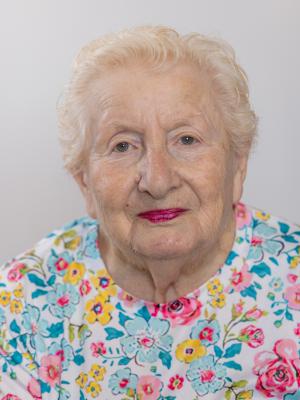Raisa (Rachel) Brodsky was born in 1937 in Sharhorod, Ukraine, to the Zubkovs, a traditional family of five. They spoke Yiddish at home, and Raisa’s brother Senia studied in a traditional heder (Jewish elementary school). They observed the Jewish holidays and owned a special set of Passover dishes that Raisa’s mother Molka stored in the boidem (crawl space). The family attended prayer services at the Great Synagogue, one of approximately ten synagogues in the town, as each workers' union established its own synagogue. As well as the traditional heder, the Jewish community in Sharhorod also opened Jewish schools, despite the efforts of the communist regime to restrict religious education. The town’s residents would mark special events in the restaurant where Raisa’s father Zamvel worked and in which the Jewish community would gather.
When Nazi Germany invaded the USSR in June 1941, the restaurant was ransacked. The manager threatened to kill Zamvel if he didn’t cover the losses. Both the Jews and the Ukrainians in the town were fond of the family and worked together to help him.
Zamvel and Molka were conscripted to forced labor. In early September 1941 the Germans passed control of Sharhorod to the Romanians, who established a ghetto in the town. Zamvel organized underground meetings in his house, and together with his Jewish and Ukrainian resistance comrades, they smuggled food, clothes, equipment, and medicine to the partisans. The leaders of the underground—the Jewish Malinsky and the Ukrainian Grechaniy—were caught, tortured at the Romanian headquarters, and executed.
Jewish deportees from Bessarabia and Bukovina in northeastern Romania were also incarcerated in the Sharhorod ghetto. A refugee family came to live with the Zubkovs, exacerbating their already cramped living conditions. In 1942, Zamvel contracted typhus. One of the refugees in the ghetto, Dr. Teich, smuggled medicines he had stolen from the Romanian headquarters to the partisans and also used them to treat Jews including Zamvel. Molka heard that homes housing typhus patients were being burned down with their inhabitants still inside, and when soldiers went door-to-door searching for typhus patients, she walked out toward them so that they would not enter the house and find her family. During this time, Raisa and her siblings huddled inside, crying. When Molka returned, her hair had turned white.
After the Red Army liberated Sharhorod in March 1944, Raisa studied mathematics and drafting, and she taught mathematics at the school run by the brother of Grechaniy, the Ukrainian partisan who had worked with her father during the Holocaust.
After the USSR permitted immigration to Israel in 1989, Raisa and her family realized Zamvel’s dream and made aliya. Raisa did not know any Hebrew, but she studied at an ulpan (Hebrew language study framework) and within a year, she had passed the mathematics teacher training course and started working at an elementary school.
Raisa and her husband Semion met another survivor from Sharhorod who told them about the Zikaron Holocaust survivors’ association. Raisa started telling her story to wider audiences and even stayed in contact with the schoolchildren who heard her testimony. She shares her memories with them and helps them with their history studies.
Raisa and Semion have two children, five grandchildren, and two great-grandchildren.







